Narrations and timings can enhance a web-based or self-running slide show. If you have a sound card, microphone, and speakers, and (optionally) a webcam, you can record your PowerPoint presentation and capture narrations, slide timings, and ink gestures.
After you have made the recording, it's like any other presentation that can be played for you or your audience in Slide Show—or you can save the presentation as a video file.

(The ability to record is available both to Microsoft 365 subscribers and non-subscribers. Subscribers get a few extra features.)
-
Turn on the Recording tab of the ribbon: On the File tab of the ribbon, click Options. In the Options dialog box, click the Customize Ribbon tab on the left. Then, in the right-hand box that lists the available ribbon tabs, select the Recording check box. Click OK.
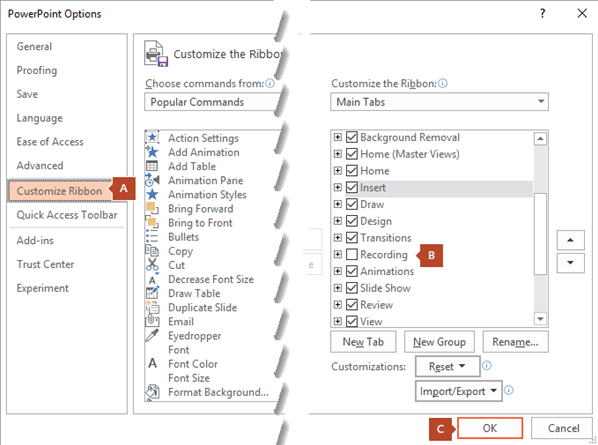
-
To get ready to record, select Record Slide Show on either the Recording tab or the Slide Show tab of the ribbon.
-
Clicking the upper half of the button starts you on the current slide.
-
Clicking the lower half of the button gives you the option to start from the beginning or from the current slide.
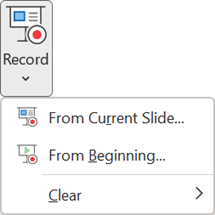
(The Clear command deletes narrations or timings, so be careful when you use it. Clear is grayed out unless you have previously recorded some slides.)
-
-
The slide show opens in the Recording window (which looks similar to Presenter view), with buttons at the top left for starting, pausing, and stopping the recording. Click the round, red button (or press R on your keyboard) when you are ready to start the recording. A three-second countdown ensues, then the recording begins.
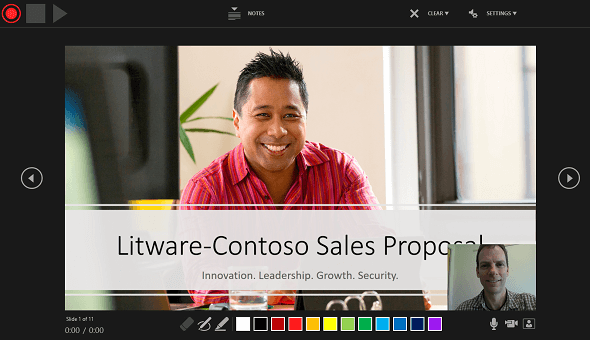
-
The current slide is shown in the main pane of the Recording window.
-
You can stop the recording any time by pressing Alt+S on your keyboard.
-
Navigation arrows on either side of the current slide allow you to move to the previous and next slides.
-
PowerPoint for Microsoft 365 automatically records the time you spend on each slide, including any Animate text or objects steps that occur, and the use of any triggers on each slide.
-
You can record audio or video narration as you run through your presentation. The buttons at the lower-right corner of the window allow you to toggle on or off the microphone, camera, and camera preview:

If you use the pen, highlighter, or eraser, PowerPoint records those actions for playback also.

If you re-record your narration (including audio and ink), PowerPoint erases your previously recorded narration (including audio and ink) before you start recording again on the same slide.
You can also re-record by going to Slide Show > Record Slide Show.
-
-
You can pick a pointer tool (pen, eraser, or highlighter) from the array of tools just below the current slide. There are also color selection boxes for changing the color of the ink. (Eraser is grayed out unless you have previously added ink to some slides.)
-
To end your recording, select the square Stop button (or press S on your keyboard).
When you finish recording your narration, a small picture appears in the lower-right corner of the recorded slides. The picture is an audio icon, or, if the web camera was on during the recording, a still image from the webcam.
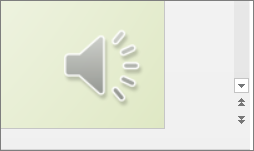
The recorded slide show timing is automatically saved. (In Slide Sorter view, the timings are listed beneath each slide.)
In this process, what you record is embedded in each slide, and the recording can be played back in Slide Show. A video file is not created by this recording process. However, if you need one, you can save your presentation as a video with a few extra steps.
Preview the recorded slide show
On the Slide Show tab, click From Beginning or From Current Slide.
During playback, your animations, inking actions, audio and video will play in sync.

Preview the recorded sound
In the Recording window, the triangular Play button near the top left corner lets you preview the recording of the slide that currently has the focus in that window.

In Normal view, click the sound icon or picture in the lower-right corner of the slide, and then click Play. (When you preview individual audio in this way, you won't see recorded animation or inking.)
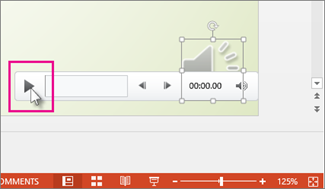
You can pause playback while previewing the audio.
Set the slide timings manually
PowerPoint for Microsoft 365 automatically records your slide timings when you add narrations, or you can manually set the slide timings to accompany your narrations.
-
In Normal view, click the slide that you want to set the timing for.
-
On the Transitions tab, in the Timing group, under Advance Slide, select the After check box, and then enter the number of seconds that you want the slide to appear on the screen. Repeat the process for each slide that you want to set the timing for.
If you want the next slide to appear either when you click the mouse or automatically after the number of seconds that you enter — whichever comes first — select both the On Mouse Click and the After check boxes.
You can use manual slide timings to the trim the end of a recorded slide segment. For example, if the end of a slide segment concludes with two seconds of unnecessary audio, simply set the timing for advancing to the next slide so that it happens before the unnecessary audio. That way you don't have to re-record the audio for that slide.
Delete timings or narration
The Clear command is for deleting timings or narration from your recording that you don't want or that you want to replace.
In the Recording window, the Clear command in the top margin of the window allows you to:
-
Clear recordings on the current slide
-
Clear recordings on all slides
In Normal view, there are four different Clear commands that allow you to:
-
Delete the timings on the currently selected slide
-
Delete the timings on all slides at once
-
Delete the narration on the currently selected slide
-
Delete the narration on all slides at once
-
If you do not want to delete all the timings or narration in your presentation, open a specific slide that has a timing or narration that you do want to delete.
-
On the Recording tab of the PowerPoint for Microsoft 365 ribbon, on the Record Slide Show button, click the down arrow, point to Clear, and then choose the appropriate Clear command for your situation.
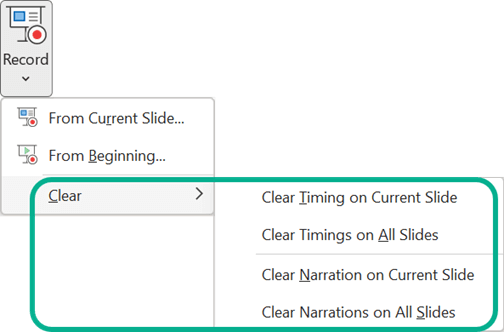
Turn off timings or turn off narrations, and ink
After you've recorded your PowerPoint for Microsoft 365 presentation, any timings, gestures, and audio you performed are saved on the individual slides. But you can turn them all off if you want to view the slide show without them:
-
To turn off recorded slide timings: On the Slide Show tab, clear the Use Timings box.
-
To turn off recorded narrations and ink: On the Slide Show tab, clear the Play Narrations box.
Publish the recording to share it with others
Once you've edited the recording to your satisfaction, you can make it available to others by publishing to Microsoft Stream.
-
With the presentation open, on the Recording tab, select Publish to Stream.
-
Type a title and a description for the video.
-
Set other options, including whether you want others in your organization to have permission to see the video:

-
Select the Publish button.
The upload process can take several minutes, depending on the length of the video. A status bar at the bottom of the PowerPoint window tracks the progress, and PowerPoint shows a message when the upload is finished:
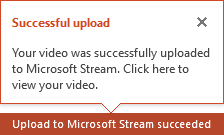
-
Click the message to go directly to the video playback page on Microsoft Stream.
Create closed captions
To make your video more accessible by including closed captions, choose from these options, which are described in separate Help articles:
Once you have a closed-caption file, you can add it to your video file by using PowerPoint.
See also
Turn your presentation into a video
Record a slide show
-
With your presentation open, on the Slide Show tab, click Record Slide Show.
-
Clicking the upper half of the button starts you on the current slide.
-
Clicking the lower half of the button gives you the option to start from the beginning or from the current slide.

(The Clear command deletes narrations or timings, so be careful when you use it. Clear is grayed out unless you have previously recorded some slides.)
-
-
In the Record Slide Show box, check or clear the boxes for your recording, and click Start Recording.
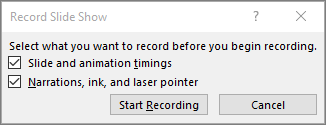
More about these options:
-
Slide and animation timings: PowerPoint automatically records the time you spend on each slide, including any animation steps that occur, and the use of any triggers on each slide.
-
Narrations, ink, and laser pointer: Record your voice as you run through your presentation. If you use the pen, highlighter, eraser, or laser pointer, PowerPoint records those for playback as well.
Important: Pen, highlighter, and eraser recording are available only if you have the February 16, 2015 update for PowerPoint 2013 or a later version of PowerPoint installed. In earlier versions of PowerPoint, pen and highlighter strokes are saved as ink annotation shapes.
-
-
At the top left corner of the window is the Recording toolbar, which you can use to:

-
Go to the next slide:

-
Pause the recording:

-
Re-record the current slide:

If you re-record your narration (including audio, ink, and laser pointer), PowerPoint erases your previously recorded narration (including audio, ink, and laser pointer) when you start recording again on the same slide.
You can also re-record by going to Slide Show > Record Slide Show.
-
-
To use ink, eraser, or the laser pointer in your recording, right-click the slide, click Pointer options, and pick your tool:
-
Laser Pointer
-
Pen
-
Highlighter
-
Eraser (This option is grayed out unless you have previously added ink to some slides.)
To change the color of the ink, click Ink Color.
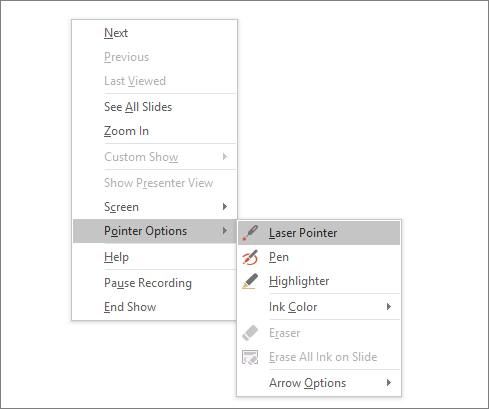
-
-
To end your recording, right-click the final slide, and click End Show.
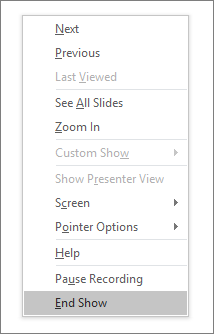
Tip: When you finish recording your narration, a sound icon appears in the lower-right corner of each slide that has narration.
The recorded slide show timings are automatically saved. Timings are shown in Slide Sorter view just beneath each slide.

In this process, what you record is embedded in each slide, and the recording can be played back in Slide Show. A video file is not created by this recording process. However, if you want a video file, you can save your presentation as a video with a few extra steps.
Preview the recorded slide show
On the Slide Show tab, click From Beginning or From Current Slide.
During playback, your animations, inking actions, laser pointer, audio and video play in sync.

Preview the recorded audio
In Normal view, click the sound icon in the lower-right corner of the slide, and then click Play.

Set the slide timings manually
PowerPoint automatically records your slide timings when you add narrations, or you can manually set the slide timings to accompany your narrations.
-
In Normal view, click the slide that you want to set the timing for.
-
On the Transitions tab, in the Timing group, under Advance Slide, select the After check box, and then enter the number of seconds indicating how long the slide should appear on the screen. Repeat the process for each slide that you want to set the timing for.
Tip: If you want the next slide to appear either when you click the mouse or automatically after the number of seconds that you enter—whichever comes first—select both the On Mouse Click and the After check boxes.
Delete timings or narration
The Clear command is for deleting timings or narration from your recording that you don't want or that you want to replace. There are four different Clear commands that allow you to:
-
Delete the timings on the currently selected slide
-
Delete the timings on all slides at once
-
Delete the narration on the currently selected slide
-
Delete the narration on all slides at once
-
If you do not want to delete all the timings or narration in your presentation, open a specific slide that has a timing or narration that you do want to delete.
-
On the Slide Show tab of the PowerPoint ribbon, on the Record Slide Show button, click the down arrow, point to Clear, and then choose the appropriate Clear command for your situation.
Turn off timings or turn off narrations, ink, and laser pointer
After you've recorded your PowerPoint presentation, any timings, gestures, and audio you performed are saved on the individual slides. But you can turn them all off if you want to view the slide show without them:
-
To turn off recorded slide timings: On the Slide Show tab, clear the Use Timings box.
-
To turn off recorded narrations, ink, and the laser pointer: On the Slide Show tab, clear the Play Narrations box.
See also
Turn your mouse into a laser pointer
What would you like to do?
Learn more about using narration in a slide show
You can record a narration before or during a slide show and include audience comments in the recording. If you don't want narration throughout the presentation, you can record comments only on selected slides or turn off the narration so that it plays only when you want it to play.
When you add a narration to a slide, a sound icon  appears on the slide. As with any sound, you can either click the icon to play the sound or set the sound to play automatically.
appears on the slide. As with any sound, you can either click the icon to play the sound or set the sound to play automatically.
To record and hear a narration, your computer must be equipped with a sound card, microphone, and speakers.
Before you start recording, PowerPoint 2010 prompts you to record either just the slide timings, just the narrations, or both at the same time. You can also set the slide timings manually. Slide timings are especially useful if you want the presentation to run automatically with your narration. Recording slide timings will also record the times of animation steps and the use of any triggers on your slide. You can turn the slide timings off when you don't want the presentation to use them.
In this process, what you record is embedded in each slide, and the recording can be played back in Slide Show. A video file is not created by this recording process. However, if you need one, you can turn your presentation into a video with a few extra steps.
Record a narration before or during a slide show
-
When you record a narration, you run through the presentation and record each slide. You can pause and resume recording any time.
-
Ensure your microphone is set up and in working order prior to recording your slide show.
-
On the Slide Show tab, in the Set Up group, click Record Slide Show
 .
. -
Select one of the following:
-
Start Recording from Beginning
-
Start Recording from Current Slide
-
-
In the Record Slide Show dialog box, select the Narrations and laser pointer check box, and if appropriate, select or clear the Slide and animation timings check box.
-
Click Start Recording.
Tip: To pause the narration, in the Recordingshortcut menu, click Pause. To resume your narration, click Resume Recording.
-
To end your slide show recording, right-click the slide, and then click End Show.
-
The recorded slide show timings are automatically saved. You can see the timing in Slide Sorter view below each slide.
Preview a narration
-
In Normal view, on the slide, click the sound icon
 .
. -
On the ribbon, under Audio Tools, on the Playback Tools tab, in the Preview group, click Play.
Record comments on a slide
-
In Normal view, click the slide that you want to add a comment to.
-
On the Insert tab, in the Media group, click the arrow under Audio, and then click Record Audio.
-
To record the comment, click Record, and start speaking.
-
When you are finished recording, click Stop.
-
In the Name box, type a name for the sound, and then click OK.
A sound icon
 appears on the slide.
appears on the slide.
Set the slide timings manually
PowerPoint 2010 automatically records your slide timings when you add narration, or you can manually set the slide timings to accompany your narrations.
-
In Normal view, click the slide that you want to set the timing for.
-
On the Transitions tab, in the Timing group, under Advance Slide, select the After check box, and then enter the number of seconds that you want the slide to appear on the screen. Repeat the process for each slide that you want to set the timing for.
Tip: If you want the next slide to appear either when you click the mouse or automatically after the number of seconds that you enter—whichever comes first—select both the On Mouse Click and the Automatically After check boxes.
Turn the slide timings off
Turning off the slide timings does not delete them. You can turn the timings back on at any time without having to recreate them. However, when the slide timings are turned off, your slides won't automatically advance when you record a narration, and you will need to manually advance the slides.
-
In Normal view, on the Slide Show tab, in the Set Up group, click Set Up Slide Show.
-
Under Advance slides, click Manually.
Tip: To turn the timings back on, under Advance slides, click Using timings, if present.
Delete timings or narration
The Clear command is for deleting timings or narration from your recording that you don't want or that you want to replace. There are four different Clear commands that allow you to:
-
Delete the timings on the currently selected slide
-
Delete the timings on all slides at once
-
Delete the narration on the currently selected slide
-
Delete the narration on all slides at once
-
If you do not want to delete all the timings or narration in your presentation, open a specific slide that has a timing or narration that you do want to delete.
-
On the Slide Show tab of the PowerPoint ribbon, on the Record Slide Show button, click the down arrow, point to Clear, and then choose the appropriate Clear command for your situation.
See also
Prepare to record
To begin, open the presentation you want and click the Slide Show tab.
Tip: If your presentation has a lot of slides, you might find it more convenient to work in Slide Sorter view. Click View > Slide Sorter to try it out.
Here are some things to check before you begin recording:
-
If you want to record only part of your slide deck, do one of the following before you begin:
-
Select the slides you don't want to include, and click Hide Slide.
OR
-
Click Custom Show > Custom Slide Show > + (add).

-
-
Use the Rehearse button to change the timing between slides without affecting the narration or gestures you've already recorded.

-
Make sure your microphone is set up correctly. On the Mac, go to System Preferences > Sound.
Record your slide show
If you want to add narration or commentary to the slide show, make sure your microphone is set up and working.
To start recording:
-
Click the Slide Show tab, select the slide where you want the recording to begin, and then click Record Slide Show.

-
During recording, use Ctrl+click to access the recording commands that let you navigate through the slides, change cursors, or trigger screen blackouts or whiteouts.
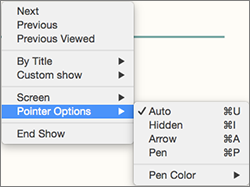
-
Click End Show to stop recording.
-
A Save dialog box appears. Click Yes to save your recording, or No if you want to record it again.
Saving overwrites anything you've previously recorded. If you want to record another slide show with the same set of slides, save your presentation file with a different name.
-
Click Play from Start to preview your recording.
Keyboard shortcuts during the recording process
You may want to print this list of keyboard shortcuts to refer to while you're recording:
| Task | Keyboard Shortcut |
| Advance to the next slide or animation | N |
| Return to the previous slide or animation: | P |
| Go a specific slide | Slide number + Enter |
| Toggle screen blackout | B |
| Toggle screen whiteout | W |
| Stop/Restart automatic show: | S |
| End slide show | Esc |
| Erase drawing on screen | E |
| Go to next slide if hidden | H |
| Change pointer to pen | Command+P |
| Change pointer to arrow | Command+A |
| Hide arrow on mouse move | CONTROL+H |
| Shortcut menu | CONTROL+click |
| Advance on mouse click (rehearsing only) | M |
Set playback options
When you've finished recording and are ready to distribute the presentation, click Set up Slide Show and choose the options that are right for your audience.
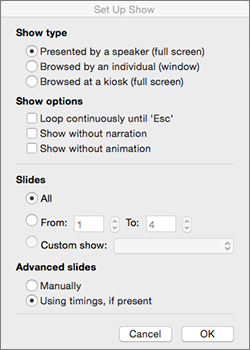
-
Show type Show full screen or windowed.
-
Show options Turn off narration or animations.
-
Slides Choose a subset of slides, or a Custom show if you've set one up.
-
Advance slides Set up this version of the slide show so someone can page through it manually.
Related information
Add, change, or remove transitions between slides
Start the presentation and see your notes in Presenter view
Record audio in PowerPoint for Mac
PowerPoint for the web doesn't support recording a slide show.
Recording tips
-
Recordings are added to the presentation on a per-slide basis, so if you want to change a recording, you only have to re-record the affected slide or slides. Also, you can rearrange the order of slides after recording without having to re-record anything. This also means it's easy to pause for a break while recording a presentation.
-
PowerPoint doesn't record audio or video during transitions between slides, so don't speak while advancing the slide. Also, include a brief buffer of silence at the beginning and the end of each slide to make the transitions smooth and ensure that you don't cut off audible narration while transitioning from one slide to the next.
-
You can't record narration in PowerPoint for the web. Use a desktop version of PowerPoint to record your narration.
-
You can adjust and edit the size of video and ink in edit view.
-
If it's possible that your audience may use PowerPoint for the web to experience the recording, use the transitions that are supported by PowerPoint for the web (Cut, Fade, Push, Wipe, Split, Random Bars, Shape, Morph).
-
Presentation recording works best with touch-screen PCs that have a web camera.
-
Use video preview to make sure everything is set up correctly before recording.
-
For slides that you want to record gestures (such as ink) on, make multiple copies of the slide so that you can easily record multiple takes. Then delete the extraneous slides when you're done.
-
Record a few seconds of silence by turning off audio and video to advance after a set time.
-
For higher quality, use an external web cam and/or microphone.
Built-in cameras and microphones are suitable for most tasks. But if you want more professional-looking video, consider using an external web cam, if you're able. If you're using PowerPoint on a tablet or laptop and you're inking with a stylus, an external camera and microphone allows you to minimize stylus noise.
-
As soon as you finish your first slide recording, play it back.
Before you get too far down the road of recording your presentation, make sure your audio and video sound and look the way you expect.
Microsoft Office Tutorials: Record A Slide Show With Narration And Slide Timings >>>>> Download Now
ReplyDelete>>>>> Download Full
Microsoft Office Tutorials: Record A Slide Show With Narration And Slide Timings >>>>> Download LINK
>>>>> Download Now
Microsoft Office Tutorials: Record A Slide Show With Narration And Slide Timings >>>>> Download Full
>>>>> Download LINK 2T